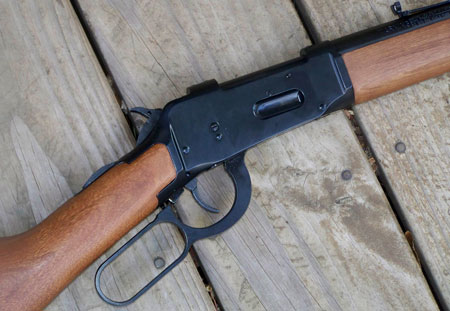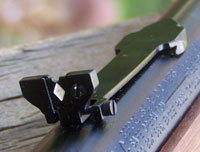
Yep, I said second try. Back in the mid-1970s, Mossberg introduced their Model 472 lever-action. Chambered in .30-30 Winchester or .35 Remington, the Model 472 was available in a number of configurations until being phased out altogether in 1983 with a final 5000-piece run of Roy Rogers commemoratives. Often encountered under the “Western Field” brand name, the Model 472 is remembered today mostly as a competent, respectable little carbine more than a little reminiscent of Marlin's similar Model 336.
Like the Model 472, the Model 646 is a competent, respectable little carbine. Mossberg insists that their new lever gun was already well under development when Winchester discontinued the sainted Model 94 in early 2006, but it's inevitable that the Model 464 will be seen as the Model 94's successor. In that role it succeeds rather well.
Let me make clear that I'm talking about the post-1964 Winchester Model 94. Mossberg stresses “affordability” as one of the key features of the Model 464, so if you're looking for bluing so deep you can swim around in it and Grade AA Fancy claro walnut, you're going to have to keep waiting or buy a high-end pre-1964 Winchester. Like most Mossbergs, the 464 is a working gun, and if you're looking for more than that you may be living in the wrong decade, if not the wrong century.
After spending a few afternoons on the range with the new Model 464, all I can tell you is that it performs as advertised, which is an increasingly rare characteristic for any new product, firearm or otherwise. For the beginner, the once- or twice-a-year deer hunter, the woods bum or the recreational shooter who wants something with more oomph than a .22 for plinking or competition, the Model 464 is an admirable little gun.
First, the basics: the Model 464 is chambered only in .30-30 Winchester, at least as of this writing. It has a 20-inch round barrel and iron sights, though its receiver is drilled and tapped for scope mounts — not side mounts but top mounts. Unlike Marlin's competing Model 336, the 464 has a straight-grip stock, which has always seemed (to me, anyway) to be more accommodating to various body types than stocks with pistol grips. As to the wood, well, it's that classic “hardwood” we've all come to know so well, and it serves its purpose.
One nice touch is the soft, serrated rubber recoil pad that gives the rifle a snug, non-slip feel.

Magazine capacity of the Model 464 is 6+1 rounds and, unlike some lever-actions I've fired recently, you don't have to be Charles Atlas to force cartridges into the loading gate.
There is no half-cock hammer safety; the only manual safety is an unobtrusive tang slider that lies naturally under the thumb. Some lever fans are going to complain about the safety, just as they did when Marlin introduced the crossbolt safety on its 336-series rifles way back in 1984. To me, a tang safety is much handier than a receiver-mounted crossbolt, and it looks better, too.
It's a hammer-block safety, so the trigger will pull and the rebounding hammer will fall even when the safety is engaged. There's also an automatic disconnector safety where the lever meets the lower tang, which is pretty much standard for modern lever-actions. We can all debate the need for a manual safety on a lever rifle, but the way I read the situation, one motivated tort lawyer swings more weight than 1000 mildly displeased consumers.
In some respects, the new Mossberg looks like a cross between a Marlin Model 336 and a late-model Winchester 94. The sliding round bolt resembles that of a Marlin, while the open-top receiver resembles that of a Winchester. Unlike the Winchester, however, the bolt is enclosed by two massive integral fore-and-aft rings that are forged in one piece with the receiver proper. The ejection port is similar to that of the Winchester Model 94 Angle Eject, and empties exit it with considerable force at nearly a perfect 45-degree angle, well clear of any scope you'd care to mount. The 464 weighs in at an advertised 6.7 lbs., a few ounces less than the walnut-stocked Model 336, with an overall length of 38.5 inches.
When you work the lever of the Model 464, the bottom of the receiver falls away to decrease the arc of the lever throw, which is short for a fairly long cartridge like the .30-30. Some may object to this “dropped-pants arrangement,” as gunwriter Henry Stebbins described it half a century ago, but it does eliminate the need for a lever lug on the bottom of the receiver. As a result, the flat bottom of the Model 464's receiver makes it easy to carry in one hand. This may seem like a minor point, but it's the kind of thing you'd notice while slogging your way back to camp in a freezing rain after spending sight hours in a deer blind with exactly one more long, hard mile to go.
So how's the Model 464 shoot? Not bad. Its action was smooth and slick — nothing wrong there. My only serious objection is its rear sight. It's a tiny sliding blade with an equally tiny set screw, much as you find on the older Henry .22 lever-actions.

As an old iron-sight man, I prefer the Marlin-style buckhorn with sliding ramp. At 50 yards, I simply could not lower the 464's rear sight enough to zero it at 50 yards, which is approximately the distance at which I took my last two Michigan deer. In fact, at 50 yards the gun shot a two-inch group that was dead on the bull but six inches high with Federal Power-Shok 170-grain softpoints. Faced with a situation like that, you can either wear yourself out cussing the rear sight, or you can just slap a scope on the thing.
I'm not enamored of scopes on lever guns, but I realize I'm in a distinct minority on that point. As for the front sight, it's a dovetailed, unhooded brass bead that shows up well enough in broad daylight. In the woods at twilight, it might be a different story — another potential reason to mount a scope.
On the Mossberg website, the company is running a poll that asks visitors what the next chambering for the Model 464 should be. I hope the Internet Police don't swoop down and arrest me, but I must confess that I voted multiple times. I'm not proud of it, but there it is. At first, I thought I'd like to see the gun in .444 Marlin, but then I changed my mind and thought how fun it would be to have a 464 chambered in .357 Magnum/.38 Special.
Then I contradicted myself again and voted for the .308 Marlin Express.
I consider Browning's BLR to be the Rolls-Royce of lever-actions. However, the MSRP of the Model 464 is only $493, with street price substantially less. So for five big bills you get the rifle, a swell Mossberg cable lock and a two-year limited warranty. That's pretty reasonable for a new gun, especially one that's so well-suited to the newbie hunter or the part-timer. I'd have been pleased as punch as find a Model 464 under the tree when I was just starting out.
Mossberg has also announced plans for a Model 464 chambered in .22 Long Rifle. This would fill the niche vacated by the late Winchester 9422 and would make an interesting understudy to the centerfire Model 464, which has plenty to recommend it in its own right.

Next Step: Get your FREE Printable Target Pack
Enhance your shooting precision with our 62 MOA Targets, perfect for rifles and handguns. Crafted in collaboration with Storm Tactical for accuracy and versatility.
Subscribe to the Gun Digest email newsletter and get your downloadable target pack sent straight to your inbox. Stay updated with the latest firearms info in the industry.

![Best Concealed Carry Guns In 2025 [Field Tested] Wilson Combat EDC X9S 1](https://gundigest.com/wp-content/uploads/Wilson-Combat-EDC-X9S-1-324x160.jpg)


![Best 9mm Carbine: Affordable PCCs [Tested] Ruger Carbine Shooting](https://gundigest.com/wp-content/uploads/Ruger-Carbine-Shooting-100x70.jpg)
![Best AR-15: Top Options Available Today [Field Tested] Harrington and Richardson PSA XM177E2 feature](https://gundigest.com/wp-content/uploads/Harrington-and-Richardson-PSA-XM177E2-feature-100x70.jpg)
